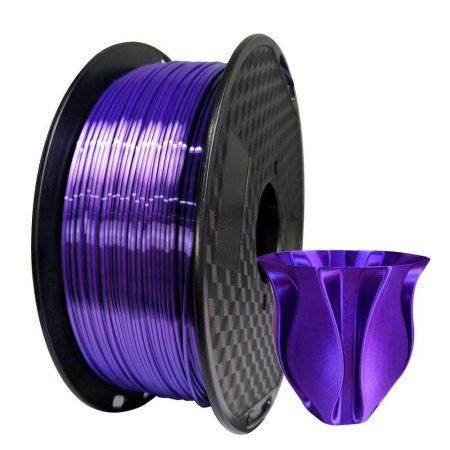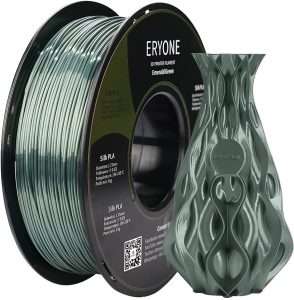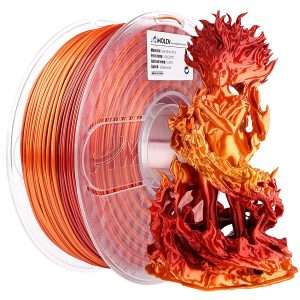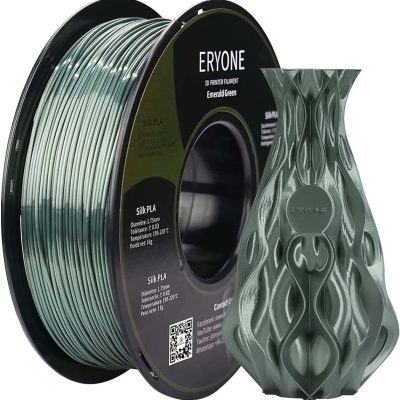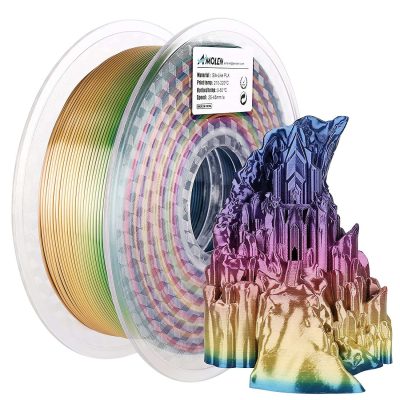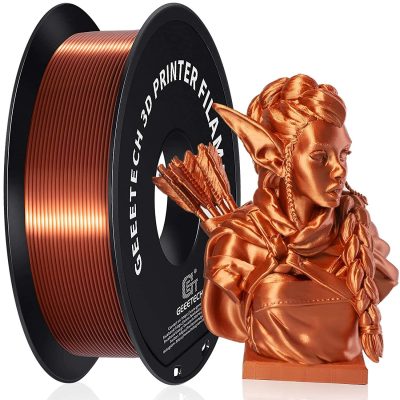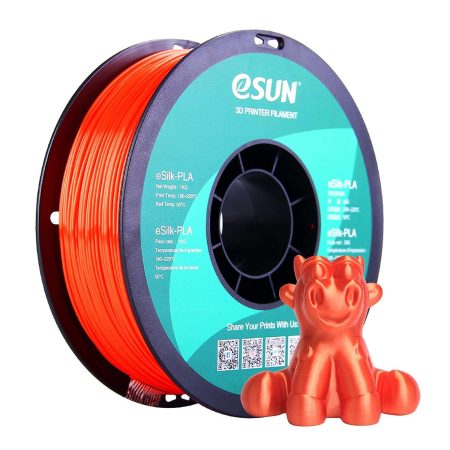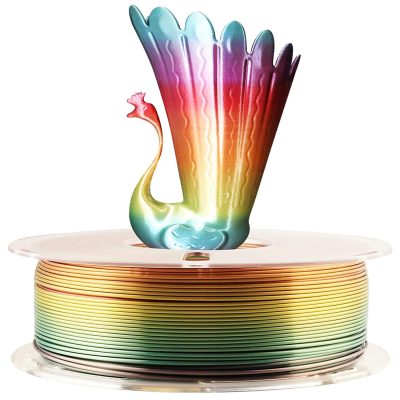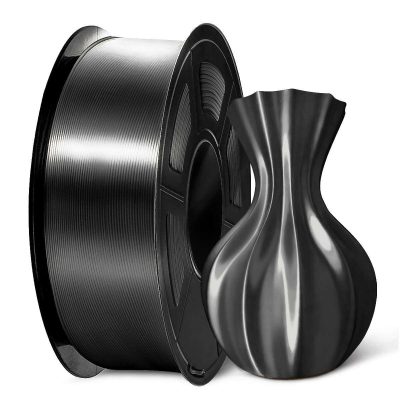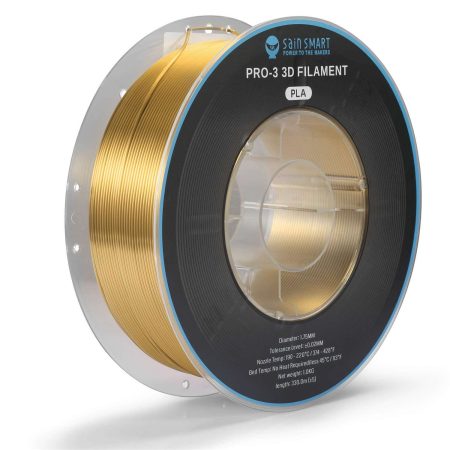- Last Updated: January 12, 2024
-
 Jackson O'Connell
Jackson O'Connell
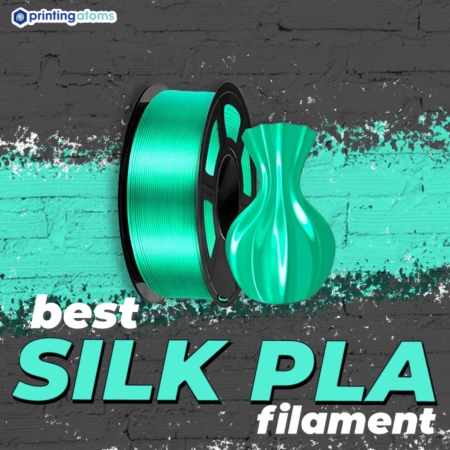 Sick of your 3D prints being so…boring? Most 3D printing filaments yield a pretty bland and matte finish on models. However, there’s another option: silk filament.
Sick of your 3D prints being so…boring? Most 3D printing filaments yield a pretty bland and matte finish on models. However, there’s another option: silk filament.
Like regular PLA filament, silk PLA filament is easy to print. However, what’s special about this type of filament is that it produces a super shiny and silky surface finish, hence its name. Silk filament is loved throughout the 3D printing community for its visual effects on prints and it’s one of my personal favorite filament choices.
In the next few sections, we’ll be going over more information about silk PLA and why it’s so special. Then, we’ll dive into our review of some of the best silk PLA filaments that you can find!
Enjoy!
Top Silk Filaments At A Glance
1. Eryone (Best Choice)
2. CC3D (Best Value)
3. Amolen (Premium Choice)
4. Geeetech (Quality Prints)
5. eSun (Most Reliable)
6. TTY3D (Easy to Print)
7. Sunlu (Strongest)
8. SainSmart
What’s With Silk PLA?
It seems over the past few years, silk PLA has been all the rage in the 3D printing community.
But what’s so special about this type of filament?
Well, most importantly silk filament provides a shiny, smooth, and silky (hence its name) surface finish on 3D prints. Basically, all filaments on the market are matte, and this type of finish on prints can get boring and old quickly. Silk PLA is a great way to spice up your prints by making them look a little extra sexy.
Silk PLA VS Regular PLA
Regular PLA filament is undoubtedly the most popular type of filament for 3D printing. It’s known throughout the land for being super easy to print, which makes it a great choice for beginners and people looking for a hassle-free printing experience.
The main downside of regular PLA filament is that it’s very weak relative to other plastic materials, like ABS and PETG filament. While less technical in nature, another negative of regular PLA is that it’s not super sexy. Moreover, prints made with regular PLA filament look somewhat dull and unappealing.
That’s where silk PLA comes in.
Silk PLA is a type of filament derived from regular PLA, but with some extra chemicals and substances (additives) mixed into the filament blend. These additives make the filament shinier so that prints made with the filament look glossier, silkier, and overall more visually appealing.
Besides the different visual properties, silk PLA is pretty much the same as regular PLA. Of course, this isn’t much of a surprise as silk PLA is primarily made of regular PLA plastic anyways. As such, silk PLA still isn’t super strong.
It’s worth mentioning that some people report that silk PLA can be a little more difficult to print than regular PLA as a byproduct of the visually-focused additives in the filament. However, in our testing lab, we noticed barely any differences, which we’ll talk about in a later section.
What is Silk PLA Good For?
So, what is silk PLA good for? As you probably expected, silk PLA is best purposed for prints that will be on display. For example, any trophies, cosplay pieces, busts, or statues are all great opportunities to use silk PLA filament.
While regular PLA will do the job, the shininess offered by silk PLA will have passer-byers saying “woah, how do your prints look so good?”.
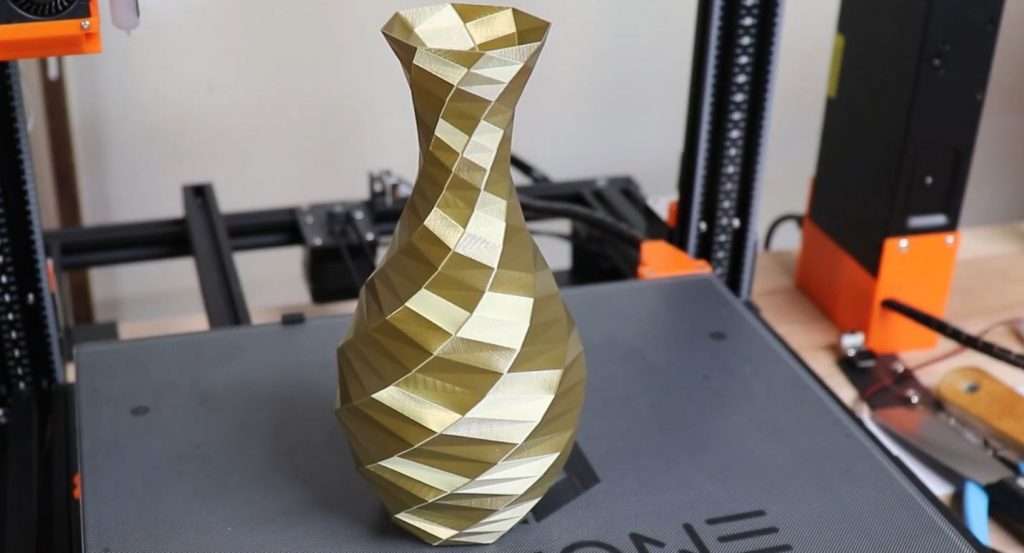
Source: Youtube Where Nerdy is Cool!
Then you can tell them that you spent centuries tuning your print settings and they’ll never know… jk.
We wouldn’t exactly recommend silk PLA for parts that you want to be stronger. However, many users have noted that silk PLA seems to be just a tad bit stronger than regular PLA. So, if you’re deciding between using regular PLA and silk PLA and want to maximize strength, the latter might be the better move.
That said, if you want the strongest variation of PLA then go for PLA+. Check out our article PLA+ vs PLA here.
Print Settings
Lastly, before we dive into the options for silk PLA filament, it’s worth going over some print settings. You can have the greatest filament in the world, but without the right print settings, your prints will still turn out low-quality.
Most of the print settings for silk PLA align with those that you’d use for regular PLA filament. For this reason, when crafting your slicer profile for this type of filament, we suggest using your current profile for regular PLA filament as the starting point.
The first and most important setting for silk PLA filament is the nozzle temperature. The best temperature for your specific silk PLA filament is usually listed on the side of the spool. However, if it’s not, somewhere between 200-225 °C should work great. If you think that’s a little high for PLA filament, then you should know that higher nozzle temps usually lead to a silkier surface finish with this type of filament.
Secondly, silk PLA usually prints best at a slightly slower speed than regular PLA filament. Not by much though. 50 mm/s should work fine and it’s only 10 mm/s slower than the typical print speed for regular PLA filament.
Finally, the layer height is another important setting. Theoretically, it can stay the same between all different types of filaments. However, I suggest using a smaller-than-usual layer height, like 0.12 or 0.16 mm, when using silk PLA filament. This will bring out the shininess of the filament more in your prints.
With your new slicer settings in place, let’s move on!
Top 8 Best Silk PLA Filament Brands:
Now that you know all about silk PLA, let’s get into the best options. As this type of filament has gotten a lot of attention for its visual effect on 3D prints, many filament manufacturers have taken a swing at making their own silk PLA filament.
We’ve handpicked the best silk PLA filaments from the masses and reviewed each in the sections below!
Our first silk PLA filament option is from Eryone. No, not everyone, Eryone: a semi-popular manufacturer of 3D printing filaments. Eryone’s silk PLA filament comes in seven colors, like gold, pink, and blue.
As for the shiny-ness, Eryone has that on lock. Many Reddit posts and other forum discussions point out that Eryone silk PLA filament yields super-shiny 3D prints.
This silk PLA filament costs a little more than regular PLA filament. However, if you’re willing to skip your daily Starbucks run for one day, you should have the spare dough to afford the filament.
And, this increase in price isn’t for nothing. The filament has a tight tolerance of just +/- 0.03 mm, so you don’t have to worry about the filament causing your hot end to jam or clog. Additionally, the high strength of Eryone silk PLA makes it useful for printing functional components that you want to have a nice visual appearance.
Pros
- Low diameter tolerance
- Very shiny effect on 3D prints
- Decent strength
Cons
- Not too many color options
- Slightly more expensive than regular PLA
- Not super strong; just stronger than other PLA options
CC3D silk PLA comes in sixteen colors, including white, blue, gold, cyan, and many more. On top of offering you a lot of customization, this filament costs basically the same as a regular spool of PLA. So you won’t have to put in any overtime at work to afford some visually-appealing filament.
On this note, CC3D silk PLA is still very shiny, despite its low price point. Where the filament is lacking, however, is its dimensional tolerance which is +/- 0.05 mm. This value is fairly high for filament nowadays and could result in a hot end clog.
However, you should be fine as CC3D silk PLA was super easy to print when we reviewed it in our underground secret lab.
Pros
- Low price and good value
- Decently visually appealing
- Pretty easy to print
Cons
- High diameter tolerance
Amolen is one of my favorite filament manufacturers as it seems every product they put out is just a banger. Their silk PLA fails to disappoint and that is why I gave this option our “premium choice” award.
Amolen silk PLA comes in 17 single colors and produces one of the most shiny effects on a 3D model that I’ve ever seen.
As if the ultra-shininess of Amolen silk PLA wasn’t enough, they also sell a few dual-color variations of their silk PLA. I especially loved the silk silver and shiny blue option as it made my ocean-themed 3D prints look spectacular. Additionally, the +/- 0.03 mm of Amolen’s silk filaments made them clog-free during printing.
Unfortunately, the premium features of Amolen silk PLA come with a more premium price. However, if you want maximum visual quality or a multi-color silk filament option, Amolen is the way to go.
Pros
- Low diameter tolerance
- Many color options; dual/multi-color options available
- Yields very shiny prints
Cons
- More expensive than other options
Geeetech is mainly known for making 3D printers, but they also have their own brand of filaments. Geeetech silk PLA is a great option for achieving quality prints, where you want a shiny exterior appearance, but also want the print to be strong and detailed.
Moreover, in our review of the filament, even small models with a lot of detail printed great!
You can pick up this filament for only a few bucks more than a spool of regular PLA. And, it’s available in ten colors, like gold, black, white, pink, and purple. The team especially loved how the silk PLA prints came out.
However, we weren’t as happy to know that we had to use a nozzle temperature of 225 °C to achieve the print. Geeetech’s recommended temperatures seem a little much for a “PLA” filament. Of course, using higher temps technically enhances the layer-to-layer adhesion for prints, so I guess it’s not too much of a downside.
Pros
- Many color options
- Decently strong
- Great for printing small features and detail
Cons
- Requires above-average nozzle temperature
eSun is another popular developer of consumer-grade 3D printers that also happens to make their own line of filament. eSun’s silk PLA filament is easily one of the most reliable on the market and our printing experience was very consistent. As such, all of our prints in this filament matched similar qualities with no inconsistencies.
Moreover, the filament has a low diameter tolerance of +/- 0.03 mm, so you likely won’t have any hot end clogs.
Additionally, eSun points out that you can print this filament with speeds up to 100 mm/s, which is faster than fast. While we didn’t go all the way up to 100 mm/s, we did use above the typical 60 mm/s speed without a noticeable drop in print quality.
Of course, this filament wouldn’t make our list if it just provided consistent-quality prints. And thankfully, it’s not. eSun’s silk PLA not only comes in 15 colors, like green and purple, but each color is also super-duper shiny.
Unfortunately, to get your hands on some eSun silk PLA, you’ll have to go a few bucks over your normal budget for a spool of PLA. However, we, along with hundreds of happy reviewers, think the price is worth it.
Pros
- Decent diameter tolerance
- Many color choices
- Very shiny and silky
- Can be printed very fast
Cons
- More expensive than other options
- Can’t be printed as fast as stated (60 vs 100 mm/s)
TTY3D isn’t as popular as the other options on this list, but their silk PLA is one hell of a filament. Specifically, TTY3D silk PLA performs well when it comes to printability.
The suggested nozzle and bed temperatures for this filament are a little higher than normal. However, our experiences with this filament were nothing but a breeze, with consistent extrusion, no clogs, and no tangles. But don’t take our word for it…take the 5,000+ positive Amazon ratings.
TTY3D silk PLA comes in almost 20 colors, including a multi-color silk option. It’s worth noting that this filament doesn’t yield as shiny or silky a finish on 3D prints as some other options on this list.
But, if you don’t want to fumble around with the tiny details on your slicer, then this filament is for you!
Pros
- Many color options
- Very easy to print
- Not sensitive to slicer settings
Cons
- Not as shiny or silky as other options
If you’re thinking “I don’t want to use silk PLA filament cuz’ it’s weak”. Well, stop right there because, boy, do we have the filament for you.
Sunlu’s silk PLA is one of the strongest silk filaments you can get. In our review of Sunlu silk PLA, we noticed that parts were a lot less brittle and fragile than models printed in the other silk PLA filaments we reviewed.
Some reviews for this product point out that prints made in this filament are weak. And this may be true when comparing models you make with Sunlu’s silk PLA to materials like ABS or PETG. However, as the saying goes, you can’t compare apples and oranges. And, Sunlu’s silk PLA is stronger than almost any other PLA filament we can find.
This filament supposedly has a dimensional tolerance of just +/- 0.02 mm, so you should be safe from hot end clogs. What you won’t be safe from, though, is the odor that this filament gives off during printing. We found it very strong, so we suggest having a fan nearby.
Pros
- Low diameter tolerance
- Yields strong prints
Cons
- Noticeable odor
- Not as shiny as other options
SainSmart is a well-known distributor of manufacturing products, like laser engravers, 3D printers, and 3D printing filament.
SainSmart’s silk PLA filament is a great overall option as it’s decently easy to print, not too expensive, and yields a fine and shiny surface finish on prints.
Moreover, this filament has a diameter tolerance of +/- 0.02 mm and SainSmart states that you don’t need a heated bed. However, we, along with many users per their reviews, used a bed temperature of 60 °C to ensure proper bed adhesion.
Other properties of this filament are its tangle-free-ness which SainSmart attributes to its manufacturing process. SainSmart silk PLA also can be printed with speeds as high as 100 mm/s for when you forgot to get your wife an anniversary gift and every store is closed (it happens).
Pros
- Low diameter tolerance
- Can be printed at high speeds
- Not very expensive
Cons
- Requires a heated bed contrary to company claims




